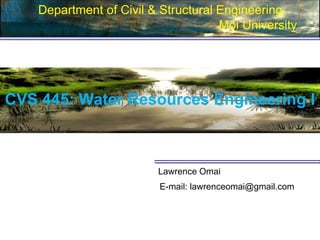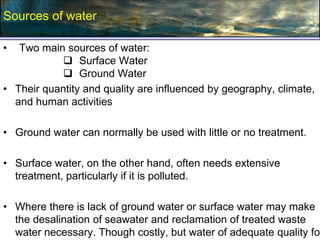Lecture 1-CVS 445.ppt
- 1. CVS 445: Water Resources Engineering I Department of Civil & Structural Engineering Moi University Lawrence Omai E-mail: lawrenceomai@gmail.com
- 2. Course Outline 1. Introduction to WRE 2. Integrated Water Resources Management and development (IWRM/D) Definition Importance Process of implementation Water management (Dublin) principles Water users Implication of change 3. Water interaction and balance 4. Catchments based planning /management 5. Legal & institutional framework and international obligation for IWRM Kenya in focus, Water ACT 2002
- 3. Course Outline âĒ Fieldwork: study an integrated water resources project. âĒ Laboratory: assessment of the sodium adsorption ratio and conductivity measurements. Reference 1. Andrew A. Dzurik (2003, Ed.), Water Resources Planning , Rowwman Publishers, UK. 2. Linsley, Ray K. eta-al, (1992, 4th Ed.), Water Resources Engineering, McGraw-Hill. 3. Integrated Water Resources Management Plans Training manual and Operational Guide March 2005
- 4. Water Resources Engineering involves/has roots in: âĒ Supply of water for human use âĒ Removing water when humans are finished using it. âĒ Developing methods of avoiding damage from excess water (floods). ï Major work of WR-Eng. is Planning and mgt of constructed facilities that address these tasks. âĒ The dvpt of water resources requires the conception, planning, design, construction, and operation of facilities to control and utilize water. âĒ It is basically a function of civil engineers Introduction to WRE
- 5. Introduction to WRE contâdâĶ ï Water resource problems are also the concerns of environmentalists, economists, political scientist, geologists, electrical and mechanical engineers, chemists, biologists and other specialists in the natural and social sciences. ï Career opportunities undergraduates & Graduates can be found in consulting firms and in government entities charged with supplying water or dealing with its hazards.
- 6. Fields of water Resources âĒ Control of Water: to avert property damage e.g. highway culvert design, flood mitigation, sewerage, land drainage etc. âĒ Utilization of Water: beneficial use e.g. Water supply, irrigation, hydro-electric power development, and navigation improvement. âĒ Water Quality Management: Pollution threatens the utility of water for municipal and irrigation.
- 7. âĒ Little skill is required to design a structure for some purpose if unlimited funds are available. âĒ The special ability of the engineer is reflected in the planning of projects which serve their intended purpose at a cost commensurate with the benefits. âĒ COST-Benefit Analysis necessary âĒ Should be demonstrated that Cp<<Bexp to warrant the required investment. âĒ Engineers plan for the uncertain future without know how whether the loads used to design structures cannot be exceeded. âĒ Generous factors of safety are used to lower the probability of failure which may increase the cost of the project. âĒ To have a compromise between safety and economy, the Economics in water resources
- 8. For example, the occurrence of a flood with probability p in N years can be estimated as follows: 1. If the probability of occurrence is, p, 2. Then probability of not occurring is = (1 â p) 3. Probability of not occurring in 2 years is = (1 â p) (1 â p) = (1 â p) 2 4. Probability of not occurring in n years = (1 â p) n For N = n; 5. Probability of occurring once in N years is = 1 - (1 â p) N Economics in water resources contâdâĶ.
- 9. âĒ Two main sources of water: ïą Surface Water ïą Ground Water âĒ Their quantity and quality are influenced by geography, climate, and human activities âĒ Ground water can normally be used with little or no treatment. âĒ Surface water, on the other hand, often needs extensive treatment, particularly if it is polluted. âĒ Where there is lack of ground water or surface water may make the desalination of seawater and reclamation of treated waste water necessary. Though costly, but water of adequate quality for Sources of water
- 10. Surface water âĒ Rivers and lakes are important sources of public water supplies because of high withdrawal rates they can normally sustain. âĒ Surface waters are open to pollution of all kinds. âĒ Contaminants arise from industrial and municipal wastes, run off from urban and agricultural areas, and soil erosion at river catchments. Storage of surface water âĒ A water supply, irrigation, or hydroelectric power project drawing water directly from a stream may be unable to satisfy the demands of its consumers during low flows. âĒ Hence necessity of dam construction
- 12. Surface water storage contâdâĶ 1. The normal pool level: is the maximum elevation to which the reservoir surface will rise during ordinary operating conditions. âĒ For most reservoirs normal pool is determined by the elevation of the spillwa crest or the top of the spillway gates. 2. Minimum pool level: is the lowest elevation to which the pool is to be drawn during normal operating conditions. 3. Useful storage: The storage volume between the minimum and the normal pool levels. 4. Dead storage: The water below minimum pool level. 5. Surcharge storage: discharge over & above the spillway, experienced during flooding.
- 13. Determining capacity of a reservoir 1. Formulae for volumes of solids: Can be used for reservoirs of regular shape. 2. Capacities of reservoirs on natural sites must usually be determined from topographic surveys. ïž An area elevation curve is constructed by planimetering the area enclosed within each contour within the reservoir site. ïž The integral of area-elevation curve is the elevation storage, or capacity curve for the reservoir.
- 14. Reservoir Sedimentation âĒ The storage volume of a reservoir is affected by sedimentation. âĒ If the sediment inflow is large compared with the reservoir capacity, the useful life of the reservoir may be very short. âĒ The useful life is terminated when the Q occupied by sediment is sufficient to prevent the reservoir from serving its intended purpose. âĒ Hence soil erosion control necessary at the watershed scale. âĒ Rate of erosion is the rate at which erosion occurs and measures how much sediments are removed at a given time âĒ The ratio of sediment yield of a drainage basin to the total amount of sediment moved by sheet erosion is the sediment delivery ratio. â It is the sediment measured at a specific point over a specific time in a stream. It gives information on how a stream carries sediments from the
- 15. Reservoir Sedimentation contâdâĶ Ways of Addressing Sedimentation Problem 1. Designating a portion of the reservoir capacity as sediment storage. âĒ This is a negative approach as it only postpones the problem. 2. Selecting a point along the river where sediment inflow is very low. âĒ Some basins are more prolific sources of sediment due to soil type, land slopes, vegetation cover, land use and rainfall characteristics. 3. Soil conservation methods. 4. Provision of sluice gates; discharge of finer sediments.
- 16. Streamflow Measurement âĒ Necessary for water resource assessment studies and hydrologic balance studies. âĒ 2 broad categories of stream measurement are: â velocity area method and â dilution gauging. co = background concentration of the flow designated by q C1 = known concentration of tracer added to the stream at the rate q1 C2 = sustained final concentrations of the mixed flow with the rate q+q1 Then qco + q1c1 = (q + q1) c2, can be solved to yield The above derivation is based on the premise that the concentration c2 has stabilised in the stream flow. 1 2 2 1 q c c c c q o ï· ï· ïļ ïķ ï§ ï§ ïĻ ïĶ ï ï ï―
- 17. Groundwater âĒ Unlike other resources of the earth GW can be replenished. âĒ Difficult to explore and harness because it is invisible. âĒ Not as susceptible to pollution as surface water, but once polluted, its restoration, if even possible, is difficult and long term. âĒ Most pathogenic organisms and many undesirable substances are removed by filtering action of soil particles. âĒ The availability of GW from an aquifer at a place depends on the rates of withdrawal and replenishment (recharge).
- 18. Assignment #01 Briefly discuss the role of a water resources Engineer in the following sectors âĒ Water Supply and Sanitation âĒ Irrigation and Drainage âĒ Energy âĒ Environment

















